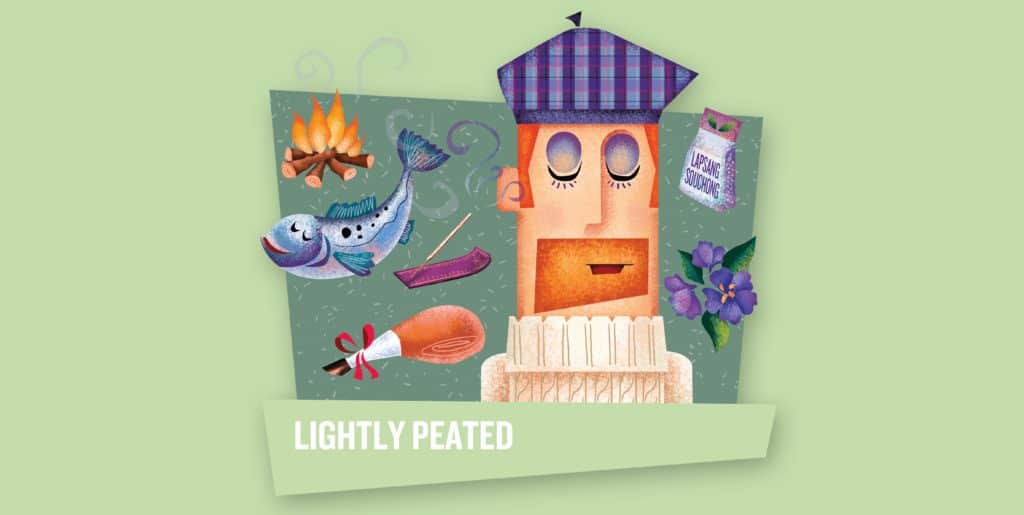Where flavour comes alive
Autumn has come and the summer heat is behind us, so gather round our seaside campfire. Are you comfortably seated?
Julien Willems embarks on a story of the Society’s trio of Peated flavour profile whiskies, a topic that will keep us busy through the short-lived autumn and into the threshold of Scotland’s night-soaked winter. Put your marshmallows on a stick and toast them over the coals, enjoy a skewer of flame grilled salmon or a slice or two of pata negra. Wash all it down with a cup of lapsang souchong and let us celebrate the flame that keeps us all going into endless new flavourful adventures.
It all begins with a saying, one probably as old as humanity in one form or another: where there is smoke, there is fire. And fire is one of the unsung heroes of whisky. It is the element that binds the entire process and history of whisky together. From providing heat to turning barley into malt, to heating (originally anyway) the ever-thirsty stills, to toasting and charring the casks, it’s impossible to overstate its importance. For every sip out there, fire helps create some of the most iconic and sought-after aromas of Scotch whisky.
Today, let us contemplate how a whisky ends up being allocated to the Society’s “Lightly Peated” flavour profile. With flavour descriptors such as toasted marshmallows and often enough a nice helping of barbecue charred fruits, the esters’ torch still burns bright.
These fruity flavoured compounds created during fermentation of the wash need no more introduction (read our Sweet Fruity & Mellow article for more on that subject). Here, smoky and peated notes are giving a bit of extra steam and length to the whisky. Burnt twigs, wood ash and smoked salmon might be divisive flavours for a drink, but if everything is coated in darker, sweeter lavender and heather honey flavours, surely this would spark anyone’s interest? All these flavours are usually associated with phenolic compounds and linked with peat burning. But how do they end up in the whisky?
Feel the heat
Before becoming malt, barley is left to soak and germinate. To grow, the plant starts secreting substances (enzymes) that will help it break down the starch in the grain into simple sugars (think barley sugar, conveniently) that can be used as a source of energy. The more the plant grows, the less sugars are left in the grain, so it is essential to nip this in the bud. And yes, you all saw this coming, fire is the answer. More specifically, hot dry air from a kiln (traditionally) is used to dry the still humid grain and stop germination. If peat is used in the furnace, its thick and aromatic smoke will grace the barley with an unmistakable brand of earthy, sooty, burnt, sometimes medicinal or dark floral aromas. These phenolic compounds then infuse the wash (malt beer that is then distilled into spirit) with aromatic properties, and distillation concentrates them further into the spirit.
In the case of „Lightly Peated“ malts, as the name suggests, the level at which the malt is peated (often heard, not always with much relevance, debated in “ppm” for ‘parts [of phenolics] per million’) is usually lower.
But equally important is how the malt is distilled. Typically, topline notes are, yes, smoky, and sometimes medicinal, but also oilier and meatier than your average unpeated drams. This may be linked to a thought we shared in the Oily & Coastal article in May: oily and phenolic compounds are heavier and less volatile than esters, ethanol and water. This means distillation will be cut off later (at a “lower point”) to leverage the phenolic aromas in the wash and low wines as much as possible. But the longer the distillation goes on, the riskier it becomes with first aromas of nuts, meat, fish and then less desirable sweaty, cheesy notes progressively finding their way through the still as well.
So, it’s all a balancing act on how many phenolic compounds you can extract while keeping your spirit clean enough, depending on the style a distiller is aiming for. But for „Lightly Peated“ malts, the trend is usually on cleanliness and restraint. Moreover, only a minute concentration of phenols will be perceptible to most, as our olfactory system is extremely sensitive to these compounds, probably at least in part due to evolutionary reasons (if you live in a forest, smelling if there is a fire is, after all, very much essential).
Cask combos
Imagine a cask that was home to a peated whisky, being emptied and re-used to mature another spirit. The Society’s Spirits Team has experimented with this in the past – recently too – and matured unpeated whiskies in casks formerly occupied by Peated or Heavily Peated flavour profile whiskies, creating some surprising and delightful new drams (think Cask No. 89.14: Omelette surprise and Cask No. 89.15: Pinball wizard or Cask No. 70.38: B+B=B² among others). But the Spirits Team has also played around with the specific types of peated flavours.
For example, with Cask No. 4.293: A cunning combo, they transferred an Orkney peated distillate from its original sherry butt to a second-fill oloroso sherry butt that had previously housed a well-aged Islay whisky (Cask No. 29.260: A visceral, elemental experience). This led to a superbly rich sherried dram, with distinct Islay and Orkney peated characteristics.
All in all, there are many ways to impart peated, smoky flavours to your whisky, particularly when considering „Lightly Peated“ drams. A little smoke and peat can truly go a long way to set passions alight. On that note, the first act of this tale comes to an end, but with autumn just over the horizon, we will be back with more considerations about peated malts and peat itself. In the meantime, make sure to crack open a bottle of „Lightly Peated“ whisky to take in the subtle complexities of this superbly varied profile.

